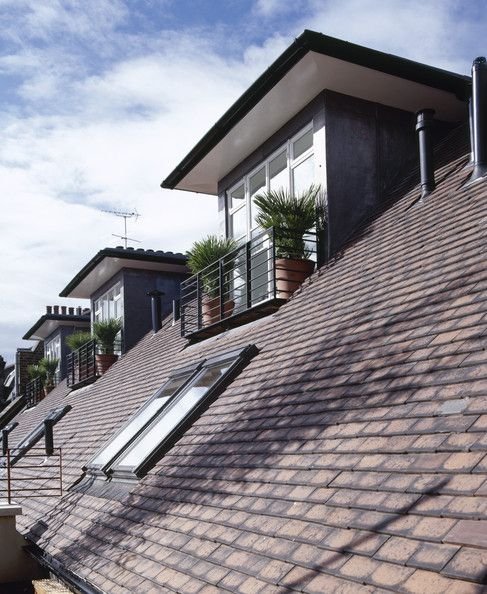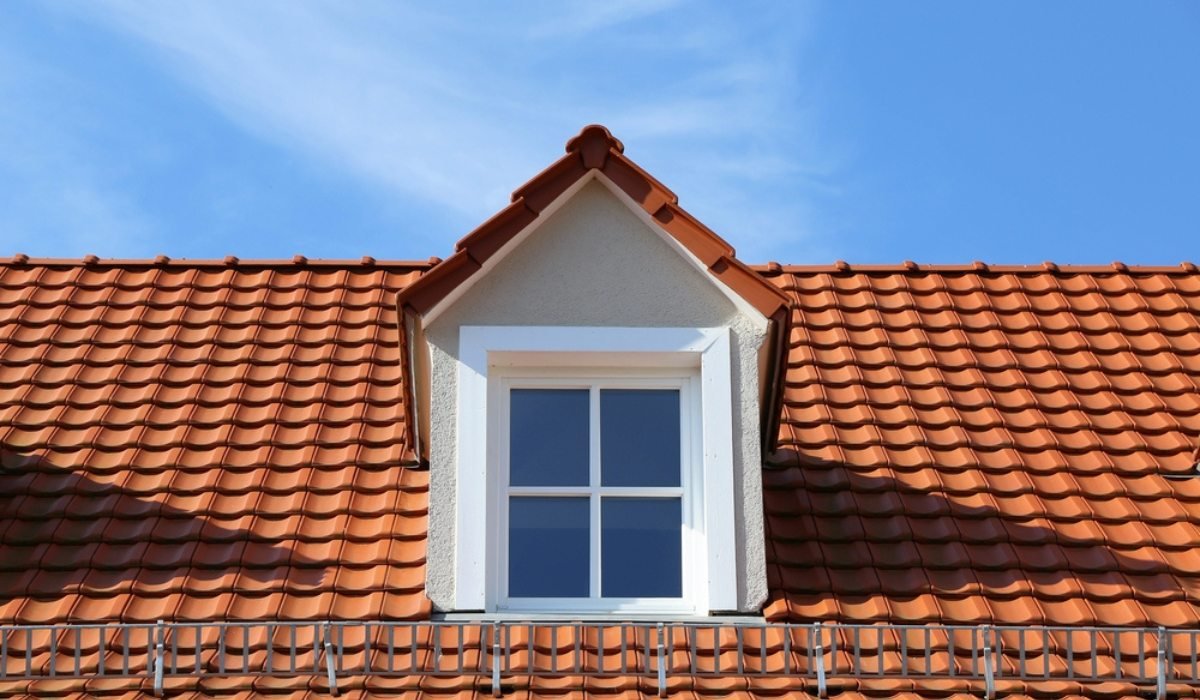If you want to boost light and ventilation, or even add extra space to your house, you might want to think about adding dormer windows. Dormer windows are located in a building’s sloping roof rather than its walls. The objective of a Dormer window is to create usable space in the loft and an entrance on the roof that admits natural light to the loft and adjacent rooms. Let’s find out more in detail.
What is a dormer window?

Source: Pinterest
Dormer windows are located on the sloping side of a roof and allow natural light to enter a room with a vaulted ceiling. Unlike skylights, which are located at an angle to the roof, dormer windows are installed vertically. They are housed in a frame structure that projects from the top of the home.
The origin of the term “dormer” is either the French word dormir, which means “to sleep,” or the Latin word dormitorium, which means “sleeping chamber.” Dormer windows were used in Europe throughout the Renaissance and gained popularity in the seventeenth century, especially in France, England, and Scotland.
Type of dormer windows

Source: Pinterest
Generally speaking, a dormer window’s style is determined by the roof design above it. Popular dormer window designs and patterns in modern architecture include:
Gable dormer window
The most popular kind of dormer window is characterised by the presence of a gable, which is a type of roof that is triangular in shape and has slopes of equal pitch above the window.
Gambrel dormer window
A gambrel dormer has a roof that has a gable at the apex of the roof, but then it drops down into two steeper roof slopes on the sides of the roof. The gambrel dormer will have the appearance of a barn as a result of this.
Hip dormer window
A hip dormer is distinguished by the presence of three roof planes: one on each side of the dormer and a third that runs parallel to the dormer’s front face. The topmost point of each of the three planes rises to a common point, which serves as the apex of the roof.
Shed dormer window
There is just one roof plane on this dormer, and it slopes in the same direction as the slope of the main roof, but at a considerably steeper angle. Sometimes the pitch of a shed dormer is so modest that it seems like it’s virtually horizontal. However, for water to drain off, there must be at least a little slope.
Eyebrow dormer window
An eyebrow dormer roof is distinguished from other types of roof planes by the presence of a softly undulating wave that rises up and fully covers the window. It is possible to create the illusion of an eye peeking out from behind a hooded lid with the help of an eyebrow dormer, which does not have any extra vertical wall sides.
Bonnet dormer window
A curving roof and vertical walls on each side of the window define a bonnet dormer as distinct architectural features. It is usual to practise installing windows in bonnet dormers that have arch-tops so that the top of the window can correspond to the arch of the bonnet.
Wall dormer window
The front of this sort of dormer is an extension of the outside wall below it, and it can have any of the roof types described above. However, this is the characteristic that distinguishes it as a distinct form of a dormer. The siding on the main portion of the house extends right up into the dormer, which makes the front of the dormer flush with the front of the house. This is accomplished by the siding on the main part of the house continuing right up into the dormer.
Lucarne dormer window
Residential lucarne dormers are often quite tall and very thin, taking their design cues from the dormers seen in Gothic cathedrals. The majority have gable roofs that extend over the window openings.
Blind dormer window
Blind dormers, sometimes known as “false” dormers, are not functional and are simply there for aesthetic purposes. Most dormer windows let light into the loft. A blind dormer appears exactly the same as an ordinary dormer window when seen from the street; however, rather than the dormer window entering the inside of the home, a blind dormer simply attaches itself to the outside of the roof. There is no sign that the dormer is there while one is inside the building.
Although it is common for a dormer roof to be a replica of the main roof, there are many variations. Architectural preferences dictate whether a gable-roofed home will have a gambrel dormer, a shed dormer, or no dormer at all. Typically, a dormer window’s roofing material will be the same as that of the main roof. In the case of a dormer window, if the main roof is covered in asphalt shingles, probably, the roof above the window will also be covered in shingles.
Benefits of dormer windows

Source: Pinterest
This section will explore some of the advantages of installing dormer windows in your home, which should help you make up your mind about whether or not you want to go ahead and do it.
More light
It might be difficult for many individuals to let natural light into their homes. The installation of the dormer windows is an easy way to accomplish this goal. These windows will let in an abundant amount of light from the outside, and as a result, your home will shine. The amount of natural light that comes into the home can be altered by modifying the orientation, material, and proportions of the dormer windows.
Ventilation
It is impossible to overstate how vital it is to have enough ventilation in the house. This is one of the most important benefits that could be gained by adding dormer windows. A room with more windows will have greater airflow, and increasing the ventilation in a room will help make it a more habitable atmosphere. Dormer window installation provides you with the highest possible level of ventilation with air drawn in from the surrounding environment.
Headroom
You’ll feel like you have more room on the inside after installing dormer windows. You are free to design whatever you choose, which will help you make more space in your home. The objective behind adding the dormer windows is to generate space which can be utilised to store furniture. Because there is no danger of the furniture obstructing a window, you are free to let it contact the wall.
Better resale value
The windows that are located on the outside of your house contribute to its attractive appearance from the outside. It is preferable for those looking in from the outside to notice the dormer windows rather than a plain wall. Because of the sophisticated appearance that the windows provide to the home, you can expect to get a lot of compliments and suggestions and increase its market value. Homebuyers who value aesthetics will be drawn to your property.
Dormer windows: Drawbacks
There are a few drawbacks of installing dormer windows in your home. These include:
Complicated installation
You’ll need to hire a professional to get a dormer window installed in your home. The installation requires complex angle-framing and reconfiguration of the rafters, which can only be done by an expert.
Added expense
It takes materials and time to build and install a dormer window in your home, which can bring up the cost of your roof. It’s even more expensive to retrofit a dormer window. All in all, depending on the size, style, and material of a dormer window, it can cost you a significant amount.
Increased risk of leak
Dormer windows penetrate the main roof of your house, which increases the risk of leaks. During the installation of windows, there is a requirement of flashing, which is a process of interweaving sheet metal and shingles to reduce the risk of leaks. But despite flashing, it is more leak-prone than other parts of the roof.
Dormer window: Useful tips
If you want to add dormers to an existing building that already has windows, the ideal time to do it is while you are replacing the shingles on the roof. This guarantees that the shingles used on both the main roof and the dormers are made of the same material and have the same colour.
The windows on dormers have to be scaled down in comparison to the windows on the walls below them. In most cases, the width or depth of the dormer windows shouldn’t be more than half of the total roof area. It is possible to get an aesthetically pleasing effect by aligning dormer windows with windows on the wall below.
Dormer window: Things to consider before adding

Source: Pinterest
As aesthetically pleasing and functional as they may seem, placing dormers on your roof requires significant effort. Before disassembling your roof, there are a few things to keep in mind:
Costs
The price of adding a dormer depends on variables like size, design, and roofing materials. Local building licences may also increase construction costs. Consider retrofitting the window at the time of shingle replacement or roof repair if your home is already constructed and you are planning a renovation. You may be able to reduce our labour and material expenses.
House style
Experts advocate constructing a dormer whose design complements the style of your home’s roof and windows. For instance, barrel dormers may be a fantastic alternative for providing contrast to a roof with a simple design. In general, gable dormers complement most house designs, while eyebrow dormers complement homes with similarly curved or arched windows or doorways.
Utility
Installing a dormer for greater living space, better lighting, and ventilation, or solely for aesthetic purposes? The use of barrel and eyebrow windows to allow in more light is acceptable, but if space is an issue, they may not be the best choice. In contrast, the installation of a shed, gable, or wall roof might make a significant impact.
Unless you have extensive construction abilities, you should not build a dormer yourself. To minimise possible dangers such as expensive roof leaks, you should employ a skilled and knowledgeable contractor.
Dormer window: A step-by-step guide for installation

Source: Pinterest
A dormer is a roof projection that can be added to an existing roof to expand the space, letting in more natural light, and providing an opportunity for creative expression. If you wish to build this extension onto your home, follow these instructions.
- Hire a roofing professional to inspect your property and provide an estimate; they can advise you on what materials would perform best, given the existing stress on your roof.
- The dormer’s placement should be deliberated about since it must not only please the eye but also make structural sense (consider how much additional weight it will need to handle).
- Create building blueprints and submit them for review by municipal authorities before starting the build.
- Do the dormer first, beginning with its layout on the attic level, and then opening the roof.
- If you want to be sure everything is up to code when construction is complete, have a roofing contractor take a look.
- Get a structural engineer’s opinion on your home’s safety. For obvious reasons, this is crucial.
- Hire a licenced roofing contractor that specialises in building dormers to finish the inside and fix the roof, if necessary.
Dormer window: How to maximise natural light?
Dormer windows serve as one of the best ways of maximising natural lighting into your home. There is a large variety of dormer windows available in a range of styles, designs, and sizes to allow as much natural light in as possible. Here are some tips on the placement of the dormer windsor for optimum natural light.
- Adding a dormer window over the staircase is a great way of drawing natural light deep into your home.
- A dormer window installed over your kitchen island bench can illuminate the work area, reducing the need for artificial lighting.
- A dormer window over a long hallway lets natural light filter into the neighbouring rooms to illuminate a large part of your home through a single window.
Dormer windows: Maintenance tips
Follow these tips to guarantee that your dormer windows are adequately ventilated without adverse impacts such as heat gain, moisture collection, and damage from severe weather:
Install windows that fit
There are two different sorts of window sizes: nominal and real. The size of the window is significant for dormers since it determines how much light enters the attic.
Window sizes are measured in nominal measurements, which are manufacturer-recommended sizes. Actual-size windows are more likely to fit your home’s walls, but they may cost more.
Window insulation against heat gain
During exceptionally warm weather, windows will lose heat via the roof and sashes, especially if they are exposed to direct sunshine. To prevent heat loss outside the house, windows must be insulated against heat gain. To avoid excessive heat transfer from rising warm air into your attic, you should insulate your dormer windows with 1/2-inch-thick foam weather stripping to impede airflow. To prevent window panels from being heated by rising warm air, insulation should be installed on all four sides.
Utilise crown moulding and complete the trim
To avoid the accumulation of moisture, you must add crown moulding and finish the window trim with a vapour barrier. If your windows are located in a region with high relative humidity, adding a vapour barrier will assist prevent condensation and keep out moisture.
Employ weatherstripping
While rain might create issues with certain windows, wind can affect any window. You must place weather stripping around your windows to protect them from wind damage.
Guarantee the safety of exposed edges
You must ensure that any exposed edges of your dormer windows are adequately fastened and covered to avoid accidents and damage. If the gap is not correctly sealed, these edges could compromise the safety of your property and allow water to enter the foundation if they are not securely sealed.
During storms, protect dormer windows with shutters
Even though dormer windows give additional ventilation during hot weather, if they are not properly covered, they may cause storm damage to your property. During storms, you must cover your dormer windows to safeguard your house. However, you should not permanently cover the window with material since it would reduce airflow. To permanently shut the window, you can use plywood with a thickness of at least 1/2 inch. Additionally, fibreglass insulation sheets may be used.
Insulate window frames properly
To prevent excessive weather from causing damage to the window frame, it must be well insulated. Avoid laying insulation directly against the wood trim by installing it on the outside of the frame. Additionally, 1″ of fibreglass or equivalent insulating material should be added to the area around the window frame.
Designing your dormer windows
When designing a dormer window, one of the most important things to remember is that it should not be too big and be in proportion with the roof. Many people end up with a one-and-a-half-storey house with dormer windows due to poor planning. With too big dormer windows, the house’s front elevation looks out of proportion, messing up the building’s visual appeal. Another thing to keep in mind is that keeping the ridges of the dormer window below the main ridge will definitely look much better. The best thing to do would be to place them slightly lower than halfway down your roof. It’s fine to have the roof pitch of the dormer window steeper than that of the main roof. But, it’s usually preferred that they are kept the same. Moreover, it’s advisable to let the dormer’s roof follow the style of the main roof to prevent it from looking odd. The best course of action is to put in a lot of effort during the design stage. So, experiment with the elevations until you land on the perfect one and choose the materials very carefully.
FAQs
What is a dormer section?
A dormer resembles a modest chamber with a window that protrudes vertically from the remainder of a sloping roof. A dormer provides for cross ventilation, admits natural light, and adds architectural character when attic space is converted into living space.
Are dormer windows worth adding?
The most apparent advantage of a dormer is the additional headroom it provides by extending from the existing roof. This could offer a plethora of alternatives for determining how the area will be used. Without this projection, you can only stand in a restricted section of the room.
Could a dormer be added to any house?
In general, a dormer can be added to any house that already has a pitched roof and attic space. Loft additions made possible by flat roofs are another problem altogether since they do not qualify as dormers. Adding a dormer to a loft that's just a little bit too tiny is a great idea since it increases the amount of vertical space available.
Should I have a dormer built without obtaining a building permit?
To qualify as an authorised development, dormer windows and dormer additions must meet the same standards as standard roof windows and skylights. Thus, unless your dormer windows are very large or you reside in a designated historic district or conservation area, you won't require special permission to install them.
What are dormer wall materials?
The majority of dormers are made of timber. The primary components of a dormer are the roof, the side walls (cheeks), and the wall facing the garden. The cheeks can be supported in one of two ways: the rafters can be doubled and fastened together, and then the cheeks can be built from the rafters.
Housing News Desk is the news desk of leading online real estate portal, Housing.com. Housing News Desk focuses on a variety of topics such as real estate laws, taxes, current news, property trends, home loans, rentals, décor, green homes, home improvement, etc. The main objective of the news desk, is to cover the real estate sector from the perspective of providing information that is useful to the end-user.
Facebook: https://www.facebook.com/housing.com/
Twitter: https://twitter.com/Housing
Email: [email protected]











